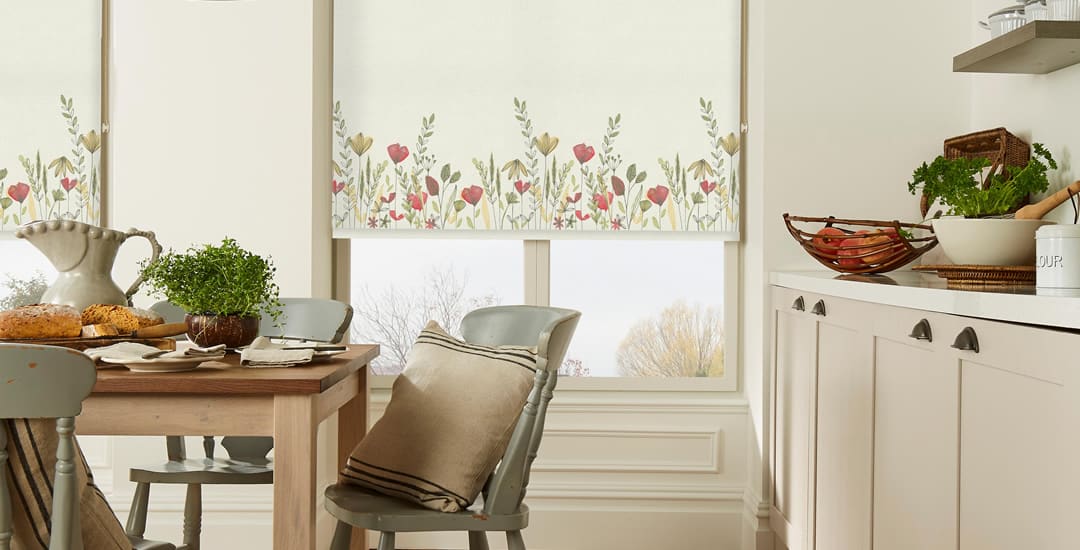
What blinds are best for kitchens? The really short answer to this is “ones that are waterproof and also easy to clean.”
This leaves you with a lot of options, but also means that some types of blinds will be off the table, because of what they’re made of.
Others might be the type that will live a long and happy life in your kitchen, but if you aren’t one to keep on top of things when it comes to cleaning, they might make you question your life choices once or twice a year when you have to spend a couple of hours de-gunking a lot of narrow slats or strips of fabric.
If you’re really into researching everything in detail, the middle chunk of this article will tell you everything you need to know about why kitchens are more challenging to pair with blinds than other rooms, and what kinds of blinds are best for kitchens to take these challenges into account.
If you just want to know what blinds are best for kitchens in terms of “buy an XXX blind” and that’s as in-depth as you’re interested in going, skip to the final section where I will list the most suitable blinds for kitchens based jointly on their ability to take the heat (or water) and their ability to not make me cry when I need to clean them.
Should you have blinds in kitchens, or are curtains a better bet?
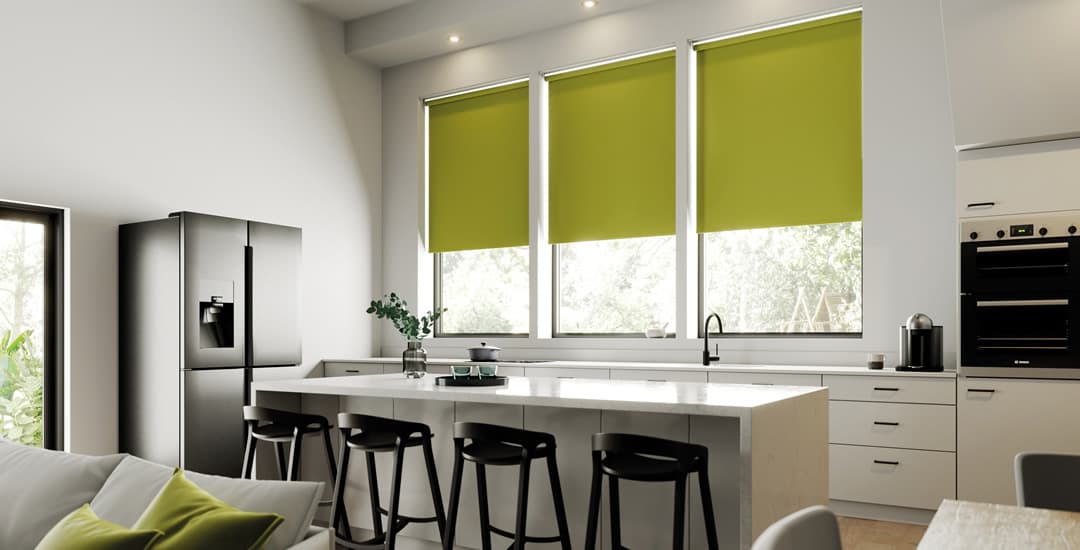
Just to get an entry-level question out of the way, should you have blinds in kitchens in the first place? Yes, unless you’re not bothered about having any window coverings at all. The alternative to blinds, being curtains, don’t tend fare well in kitchens even when said kitchen is large, airy, and not humid.
Why? Because curtains are made of fabrics that are always to some degree absorbent, which means that direct contact with water (such as splashing from a sink) or just humidity in the air are going to watermark them and make them turn limp and wrinkly and sad.
Over time they’ll start to smell damp, and also grow mould, mildew, and potentially other nasties. Other nasties like what, Polly? I’m so glad you asked.
Back when I was a student living in the type of rented accommodation that hasn’t been legal in the UK for some 20 years now, we had kitchen curtains that actually grew a small crop of poisonous-looking mushrooms in the top folds at one point. I am not even a little bit joking.
Oh, also that whole “curtains are made of absorbent fabric” thing applies to curtains not just absorbing water but also airborne grease and cooking smells.
If you walk into someone’s home and instantly pick up a whiff of eau de chip fat, catch of the day, or eye-melting balti, it is invariably the soft furnishings that are harbouring said aromas, and curtains are always the biggest culprit in this respect. Febreeze will only get you so far, trust me.
Anyway then, the short answer to “what should I put on my kitchen window” is “blinds.” Not curtains. And not just because I sell blinds, although that’s obviously a part of it.
What do you need to bear in mind when choosing kitchen blinds specifically?
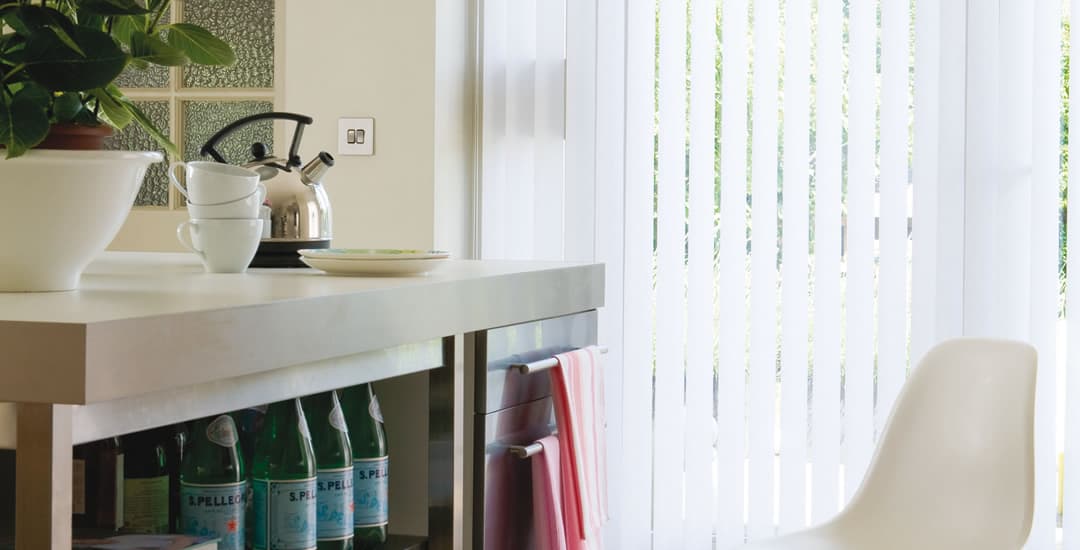
When it comes to kitchen blinds, you need to take into account the challenges that hanging out in the kitchen will result in for your new window dressings. These challenges are:
- Humidity – this is the main one, most kitchens get humid to some degree when cooking and/or washing up.
- Potentially, direct contact with water – such as often happens to blinds covering a window behind or close to a sink. Also, if you do have a super-humid kitchen, just the amount of condensation that collects on your windows can itself be enough to make the blind wet, and if you’re dealing with a small space and super-humidity, this can make blinds noticeably wet or damp to the touch too.
- Fats and oils in the air – unless your idea of a three-course meal is a salad, a pot noodle, and a tub of ice cream. Vapourised cooking fat tends to collect on things over time, including your blinds. For an added annoyance, these fats also like to attract dust and dirt to them as well.
- Cooking smells imbuing porous or absorbent fabrics – even if your usual approach to meal prep involves getting another stamp on your frequent flier card at Deliveroo.
Cooking, preparing, or just plating up fragrant food (or taking the lid off your takeout containers if relevant) creates airborne aromas.
As I always seem to bring to mind with no effort whatsoever anytime I smell something nasty even though literally nothing else from high school chemistry really seemed to stick, smell is particulate. This means that a smell is made up of invisible particles of whatever it is being caused by; they cling to and work their way into porous fabrics to create a stank that just keeps on giving long after whatever birthed it has gone.
All of these things mean that you don’t want a kitchen blind that is absorbent, porous, or hard to clean. Possessing either of those former two traits will shorten the lifespan of a blind in a kitchen, and possessing just that latter trait will shorten your temper faster than trying to wrestle a recalcitrant toddler into their shoes accompanied by a soundtrack of screams when you’re already ten minutes late.
What kind of blinds are best for kitchens?
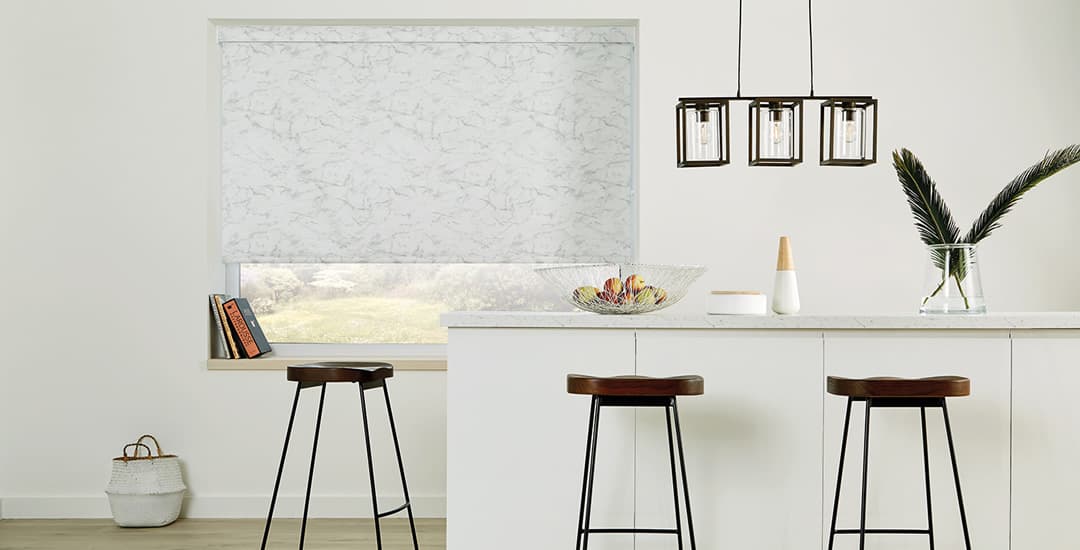
Based on the information above then, what kind of blinds are best for kitchens? Waterproof ones that are easy to clean, which I will get to in a moment.
There are a few types of blinds/materials used to make blinds that should be ruled out if you intend to use them in kitchens, because they’re made of something that is either porous/non-waterproof by nature, or are blinds that can be made in either waterproof or non-waterproof fabrics and that are ultimately crafted from the latter.
Some types of blinds come in a range of different fabric options, some of which are waterproof or moisture resistant and some of which are not, and you just need to know which is which before you start looking around.
A. When it comes to blinds that are waterproof and so, suitable for kitchens, your options are:
- PVC or vinyl roller blinds.
- PVC or vinyl vertical blinds.
- Faux-wood blinds.
- Aluminium Venetian blinds.
B. What blinds are not suitable for kitchens?
- Non moisture resistant polyester roller blinds.
- Non moisture resistant polyester vertical blinds.
- Real wood blinds.
- Roman blinds.
The lads on list B are either made of porous materials (real wood) or outright absorbent fabrics. Now, for the sake of being totally clear (“pedantic” as it is also sometimes spelled) there are definitely a few folk out there who have or who could have blinds of all of these list B types in their kitchens, and they’d be totally fine.
Said people’s kitchens are either:
Huge and very well ventilated with the windows well away from any water or aromas; or, never used; or, made by Fisher Price.
If none of that sounds like your kitchen, make your choice of kitchen blinds from list A and not list B.
What type of blinds are easiest to clean?
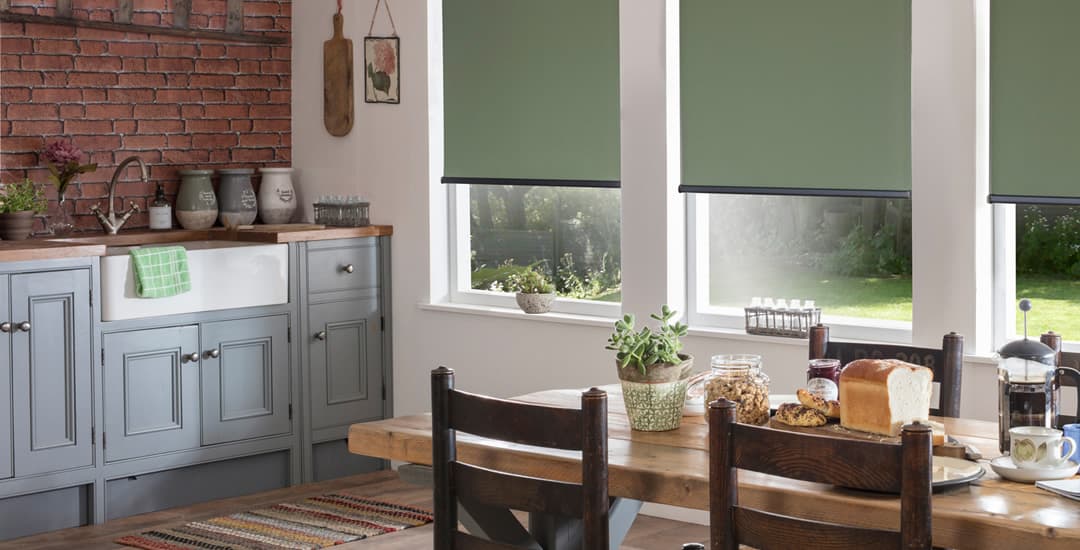
“What type of blinds are easiest to clean” is a very pertinent question for kitchens, as the blind will tend to attract dirt faster than I attract emotionally unavailable men, meaning you have to clean them more often. (The blinds I mean, the men just get recycled when the shine wears off.)
This is because humidity/moisture that gathers on a blind attracts dirt, as do cooking fats and oils in the air, which also serves to stick said dirt down quite firmly.
Few things are more fascinating and gross than running your finger along the slat of a blind and leaving a clear trail in a skin of chip fat, cat fur, and general dust bunny fusion art.
Cleaning a slatty (thank you spell check, dodged a bullet there) or louvered blind of said gummy dirt can be time consuming and less than enthralling for anyone other than Mrs Hinch, or anyone hoping to emulate her fame (and presumably, net worth).
This means that some blinds that will be totally fine for a kitchen in terms of being fit for purpose, but might just take a while longer to clean than another option.
That’s totally fine if you’re good with that; and to be fair, if you do keep on top of things by wiping your blinds down regularly, cleaning kitchen blinds will probably only take you a few minutes each time, depending on the size of the blind of course.
If you just want to know what type of blinds are easiest to clean of kitchen debris so that you can pick the least time-consuming or fiddly option, that would be PVC or vinyl roller blinds.
All of the other types of blinds that are best for kitchens are made up of either slats or louvres; which need wiping down individually front and back, taking longer than just scrubbing or wiping down a single sheet of fabric with a cloth or sponge.
What blinds are best for kitchens? The TL;DR answer
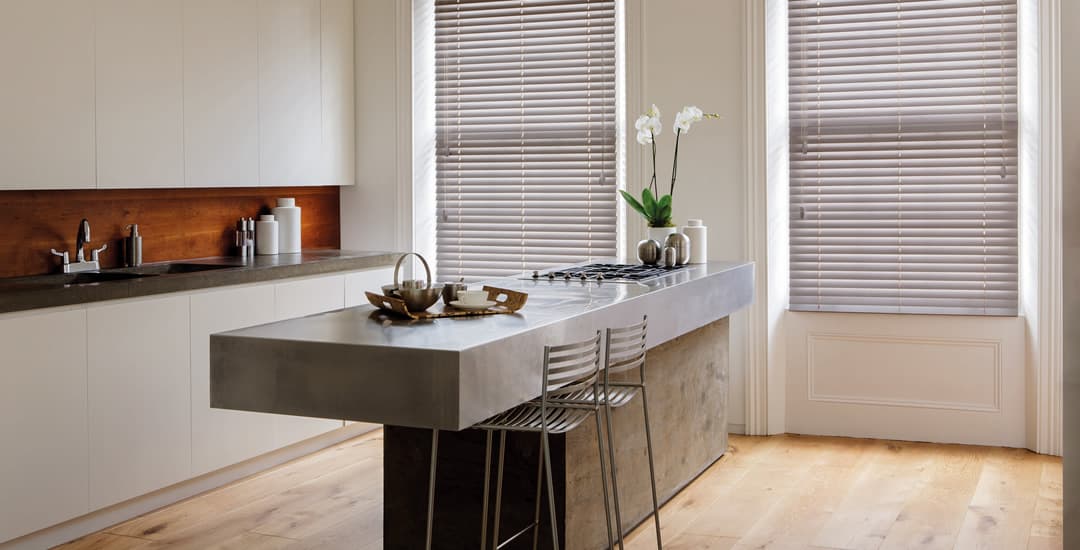
Setting aside aesthetic factors like what colour and pattern you want on your blind and whether or not your blinds can filter light and control your privacy by allowing you to enjoy the view without others seeing in, what blinds are best for kitchens?
1. Roller blinds (PVC or vinyl)
My first-place winner is vinyl or PVC roller blinds, for the dual reason that they are waterproof, and the easiest type of kitchen blinds to clean. Other points in their favour are that they tend to be the cheapest type of blinds to buy, come in the widest possible range of colour and design choices, and their fabric is blackout and flame retardant.
2. Faux-wood blinds
My second choice would be faux-wood blinds – also waterproof and fire retardant, and when it comes to cleaning them, their slats do require cleaning individually but those slats are wider (35mm or 50mm depending on your choice) than the slats on other types of slatted blinds, which makes them faster to clean.
Faux-wood blinds also give you the option to tilt their slats to filter light and control your privacy.
Faux wood blinds look virtually the same as real wood blinds, and can be made in a wide range of colours and finishes, meaning they don’t look out of place in any kitchen style.
They’re a sound choice if your kitchen involves a lot of natural materials, wood units or wood finishes such as is often the case for traditionally styled kitchens, or if you want to achieve a natural, rustic, or clean, modern finish.
3. Venetian blinds
My third choice is aluminium Venetians, as they have narrower (25mm) slats, meaning that like-for-like, there’s more slats per blind than a faux-wood of the same size, meaning they take longer to wipe down.
Again though their slats can be tilted to offer light filtering and heightened privacy, and they come in a wide range of colours and finishes.
4. Vertical blinds (PVC or vinyl)
In fourth place I put vinyl or PVC vertical blinds, as cleaning vertical louvres is a bit more time consuming that cleaning horizontal slats, even though each louvre is wider.
This is because they’re made of fabric rather than a hard material and so are a bit floppy and harder to keep hold of. However, for a really tall or wide kitchen window, verticals might actually be your best choice as other blinds top out in terms of realistic maximum size they can be made in.
Also, if and when you need to give vertical kitchen blinds a really proper clean, it is worth mentioning that some vertical blinds can be put in the washing machine to bring them up as good as new.
5. (Joint) 5th place: Roman blinds or real wooden blinds
Finally, Roman blinds and/or real wood blinds are my joint last placed options, as their lack of waterproof-icity for the former and porosity for the latter makes them only good candidates for kitchens that do not function as kitchens in the way that most of us understand the term.
For your castle, show home, or “billionaire with an ornamental kitchen of their own and another, real one for their team of chefs to actually cook in” however, Roman blinds or wooden blinds would be fine.




